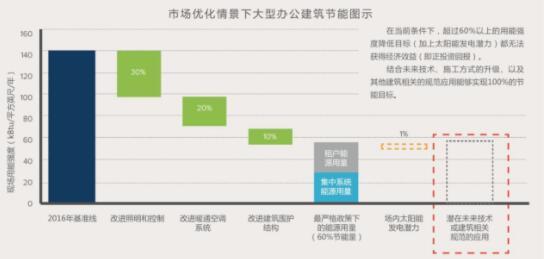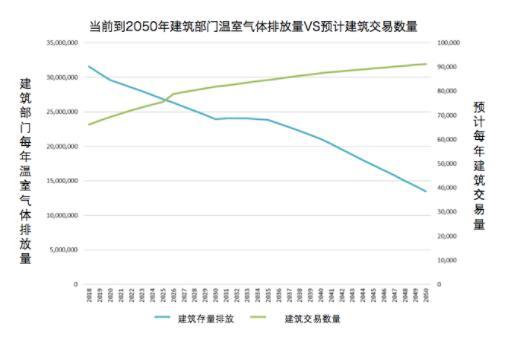Promote high-performance building development with innovative policies
Although the city only accounts for 2% of the Earth's land area, it consumes more than two-thirds of the world's energy and emits more than 70% of the world's carbon dioxide. Many cities recognize their carbon footprint and have made emission reduction commitments to conduct emissions audits for specific sectors to determine emission reduction targets. At the same time, most cities have seen that the energy consumption of existing buildings is the largest source of carbon emissions in cities – in the three most populous cities in the United States, the carbon emissions of existing buildings are as high as 64% to 73%. Most existing buildings have a life span of more than a few decades, and they have long-term lack of maintenance and have great potential for economical energy efficiency retrofits.
To reduce urban carbon emissions and achieve emission reduction targets, reducing energy use in existing buildings is key. Many cities have implemented various policies and plans for energy efficiency in existing buildings and have made real progress in the carbon reduction process. However, many of these policies involve only technical-level measures, and do not integrate more measures to achieve more energy and cost savings in an integrated manner that focuses more on overall deep transformation. Cities want to achieve carbon reduction targets in a fast and economically viable way, and an integrated building and urban energy efficiency design is essential.

Figure 1: Feasible energy intensity savings based on cost estimates and technology potential
The Rocky Mountain Institute's latest report, “Innovative Policies Drive High-Performance Building Development: A New Efficient Approach to Urban Emissions Reduction, Cost Reduction, and Job Creation” describes how cities can use comprehensive policy practices to build quickly and economically. Energy efficiency and distributed renewable energy systems. Integrating different policy elements can boost employment, raise taxes, and develop new markets for renewable energy and energy efficiency while inciting significant carbon emission reduction potential. To fully understand the effectiveness and impact of existing building-related policy norms, it is necessary to fully understand the baseline energy consumption and to assess the relevant specifications using a holistic model covering all sectors of the city.
Policy framework that can drive deeper emissions reductions
The Rocky Mountain Institute has developed an integrated framework to develop building renovation specifications that will drive emissions reductions in deeper cities. We tested the effectiveness of the framework in New York City and analyzed and developed a series of policy recommendations. These policies will enable New York to achieve its 80% reduction target by 2050. The framework is based on a series of results-oriented energy specifications and other key elements and includes the following four steps:
1. Identify valid and appropriate trigger events: Trigger events refer to events that trigger energy efficiency upgrades and match key market intervention points, such as time nodes for building sales or rentals. Combining building retrofits with key trigger events such as market events and building life cycle events can make retrofit projects more economical and easier to implement, and it is more reasonable to apply retrofit specifications at this stage. The report details a series of triggering event nodes, including the sale node, the building refinancing node, and the main equipment life-expiration node.
2. Integrated interventions: Core “events” caused by triggering events can be called energy upgrades. Importantly, such needs will point to more integrated solutions that prioritize projects that enable multiple building systems to save energy and complement other energy efficiency goals.
3. Learn about the pain points of the existing building market and which building types can be retrofitted in the simplest and most cost-effective way. The report covers various contributing factors from building inventory life to local building costs
4. Apply iterative and rigorous cost optimization to ensure market stability: The iterative evaluation process, including economic analysis, is critical in analyzing policy mix. Although the effectiveness of a policy specification depends to some extent on the results of emissions reductions, a specification can only work best if it is market-feasible. This requires the protection of affordability and market stability.
The Rocky Mountain Institute's latest report, “Innovative Policies Drive High-Performance Building Development: A New Efficient Approach to Urban Emissions Reduction, Cost Reduction, and Job Creation” describes how cities can use comprehensive policy practices to build quickly and economically. Energy efficiency and distributed renewable energy systems. Integrating different policy elements can boost employment, raise taxes, and develop new markets for renewable energy and energy efficiency while inciting significant carbon emission reduction potential. To fully understand the effectiveness and impact of existing building-related policy norms, it is necessary to fully understand the baseline energy consumption and to assess the relevant specifications using a holistic model covering all sectors of the city.
Policy framework that can drive deeper emissions reductions
The Rocky Mountain Institute has developed an integrated framework to develop building renovation specifications that will drive emissions reductions in deeper cities. We tested the effectiveness of the framework in New York City and analyzed and developed a series of policy recommendations. These policies will enable New York to achieve its 80% reduction target by 2050. The framework is based on a series of results-oriented energy specifications and other key elements and includes the following four steps:
1. Identify valid and appropriate trigger events: Trigger events refer to events that trigger energy efficiency upgrades and match key market intervention points, such as time nodes for building sales or rentals. Combining building retrofits with key trigger events such as market events and building life cycle events can make retrofit projects more economical and easier to implement, and it is more reasonable to apply retrofit specifications at this stage. The report details a series of triggering event nodes, including the sale node, the building refinancing node, and the main equipment life-expiration node.
2. Integrated interventions: Core “events” caused by triggering events can be called energy upgrades. Importantly, such needs will point to more integrated solutions that prioritize projects that enable multiple building systems to save energy and complement other energy efficiency goals.
3. Learn about the pain points of the existing building market and which building types can be retrofitted in the simplest and most cost-effective way. The report covers various contributing factors from building inventory life to local building costs.
4. Apply iterative and rigorous cost optimization to ensure market stability: The iterative evaluation process, including economic analysis, is critical in analyzing policy mix. Although the effectiveness of a policy specification depends to some extent on the results of emissions reductions, a specification can only work best if it is market-feasible. This requires the protection of affordability and market stability.
These measures and methods can greatly accelerate the application of building codes in the city, based on the appropriate triggering events of each building, follow the normative guidelines oriented to actual energy consumption results, and can be adjusted according to the characteristics of each city, with strict and objective Ways to support the feasibility of market applications.
Practical application of building policy norms - case study findings
The Rocky Mountain Institute used this approach to evaluate a New York City policy for energy efficiency upgrades at building sales nodes and found:
If the building sales node energy efficiency mandatory policy is applied, the City of New York can achieve 67% carbon reduction in the construction sector by 2050 (including emission reductions under current regulations, grid reductions, emission reduction targets for solar power generation, and fuel transition zones). The resulting emission reductions can help the city achieve its goal of achieving 80% overall carbon reduction by 2050.
Through deep energy efficiency retrofits, buildings can actually achieve an average energy saving level of 60%.
Based on an assessment of the payback period and net present value, a single energy efficiency upgrade project is economically viable until the energy savings reach 30-50%.
As building energy efficiency upgrades and on-site renewable energy projects are subject to space and economic constraints, policy requirements can be met temporarily by applying local renewable energy as an alternative to triggering events.

Figure 2: Outlook for annual emissions reductions in New York City by 2050 in the context of application sales node policy recommendations
In conclusion
Cities and states need to apply positive policy practices to reduce emissions from existing buildings and achieve their climate goals. They need to tailor their energy conservation policies to the characteristics of their respective cities and market patterns to maximize impact. In addition, to achieve the full impact of policy norms, understand its feasibility and market dynamics, and identify potential application barriers, it is also necessary to develop a comprehensive model with city-wide influence.
This approach to developing integrated policy practices can help cities take a solid first step toward achieving and exceeding their greenhouse gas reduction targets. We hope that major cities will actively apply this guide. If there is any problem, they can also contact the Rocky Mountain Institute.
The first step in committing to emission reduction targets has been completed, and today our cities need to take action by developing and applying positive policy norms.
